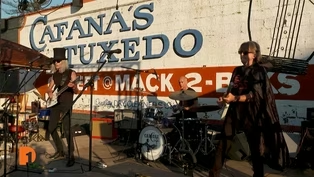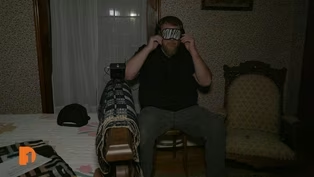
Searching for paranormal activity at The Whitney in Detroit
Clip: Season 10 Episode 17 | 9m 18sVideo has Closed Captions
One Detroit’s Chris Jordan goes ghost hunting at The Whitney Mansion in Detroit.
The Whitney, a restaurant in a historic Detroit mansion, is also one of the city’s most famously haunted places. The 19th-century mansion of lumber baron David Whitney Jr. has had several deaths on its premises over the years, and guests and employees have shared experiences of encounters with spirits. One Detroit’s Chris Jordan visits The Whitney to learn about its history and go on a ghost hunt
Problems playing video? | Closed Captioning Feedback
Problems playing video? | Closed Captioning Feedback
One Detroit is a local public television program presented by Detroit PBS

Searching for paranormal activity at The Whitney in Detroit
Clip: Season 10 Episode 17 | 9m 18sVideo has Closed Captions
The Whitney, a restaurant in a historic Detroit mansion, is also one of the city’s most famously haunted places. The 19th-century mansion of lumber baron David Whitney Jr. has had several deaths on its premises over the years, and guests and employees have shared experiences of encounters with spirits. One Detroit’s Chris Jordan visits The Whitney to learn about its history and go on a ghost hunt
Problems playing video? | Closed Captioning Feedback
How to Watch One Detroit
One Detroit is available to stream on pbs.org and the free PBS App, available on iPhone, Apple TV, Android TV, Android smartphones, Amazon Fire TV, Amazon Fire Tablet, Roku, Samsung Smart TV, and Vizio.
Providing Support for PBS.org
Learn Moreabout PBS online sponsorship(traffic humming) - Once we start it running like this, you let it run for a second, but then we'll start asking questions, hopefully questions that make sense to them, the spirits, something that's relevant, but if anybody has a question, ask it out loud.
- Do you like that we're up here?
(loud static) - [Person] No.
(loud static) - [Chris] Well, it's something.
- [Andrea] Do you like that we're up here?
(loud static) - [Person] No.
(loud static) - [Chris] Chad and Heather Dye are paranormal investigators under the name Dye Paranormal.
They're also the official resident ghost hunters at The Whitney, the 19th century lumber baron's mansion in Detroit, which is now an iconic restaurant, and which has long been said to be haunted.
They invited "One Detroit" to participate in one of their twice-a-month public ghost tours.
- It's good being the resident investigators because we get to come back to a place that's familiar, we get to try some of the same things we've tried before, maybe with a different result, but hopefully, if there are spirits here, they get used to seeing us, they'll, you know, maybe know us, maybe that'll give them an opportunity to reach out to us.
That's our hope.
- Make them more comfortable as opposed to just walking into a random space that you've not been in before, I think that maybe this year we've gotten to a point where they're starting to engage with us more.
That was loud and clear to me.
- We take people out to the carriage house and we try to recreate some of the things we've done in the past to try and quantify, you know, what's happening out there, and like I said, we can't make things happen, we can only hope that maybe one of the guests, their vibe, their energy will cause a spirit to connect with us, and that's what we're there for, we want to connect in a respectful way to whatever spirits are here and hopefully get answers from them as to why they're here.
- [Chris] But first, I spoke to The Whitney's house historian, Yvonne Szymczak, to learn more about the building's rich history.
- So before it was Motor City, it was Lumber City, and David Whitney Jr.
was the most successful lumber baron in the state of Michigan.
The Whitney family lived in the house from 1894 when the build was completed, and it was until about 1917 when David Whitney Jr.
's wife, Sarah, had passed, by choice of the Whitney family, they wanted to give it to the Wayne County Medical Association, which they did do, so that was the next in line in terms of ownership.
(whimsical piano music) My favorite stories are the ones that come from the people that come here, and I had a gentleman on one of the tours tell me, "I know about this place in a totally different context!"
And he said, "My grandfather came here to get a physical so that he could go off to war."
- How does your job as a historian kinda interact with the myths and legends and folklore of this place, being a famously haunted building?
- It validates a lot of things, it opens up a lot of questions, it just makes things more colorful.
It brings things to life and it gives people names, you suddenly have names of people that have been here, you know, and it's not just the Whitneys, because this place was a party house, I mean, this place was wired by Thomas Edison, this place has seen a lot of notable people pass through it.
- So you're the resident historian, we're also here with the resident paranormal investigators, how do your different worlds interface?
- Our stories intertwine because the... There's so much of that history that backs up a lot of those stories that lead people to ask, "Hey, who haunts this place?"
I mean, obviously we think David Whitney Jr., but why?
he died in his bedroom.
This is something that people are really intrigued with and they often say, "I can feel that, I can feel that in this room," it gives them something to hang onto.
- We know for a fact from our research, three people have died in the house.
We don't know if anybody died during the construction of the house.
We know David Whitney Jr.
died in the house in his bedroom.
After he had passed, it's believed that Sarah, his wife, moved in her brother and parents for a short time.
Her brother, John McLaughlin died in... On... In the house, on property, and then, of course, she died after, like, an 18-month illness being bedridden.
- We are always exchanging stories and photographs and videos and EVPs and it all makes sense because as you talk about the story of the house, and the story spans from 1894 to now, that ghost storytelling culture has been such a part of it.
- The carriage house is where a lot of the paranormal activity is said to happen.
What's the history of why that would be?
What's the history of the carriage house?
- One of the youngest daughters, Catherine, did take care of orphans, and there's a connection somewhere in there having to do with the sound of children's voices.
- We have an EVP audio capture, electronic voice phenomenon, for those who don't know, of a guest asking, "Would you like me to get out of your seat?"
And I was wearing headphones, and I heard, "Yes," whispered.
Nobody else heard it because I was running my audio recorder with my headphones on, so I said, who said "Yes?"
And I'm looking at the crowd thinking somebody's pulling my leg, and they're all like, "What are you talking about?
What do you mean?"
And I hear "I said yes" underneath it.
- Can you say hello for us?
- [Chris] What are the tools that you use?
- I always tell everyone that you, yourself, are your primary tool.
What you feel in a space, the energy that you pick up, you know, did it change?
Did it shift?
Did the temperature drop?
And then, the first tool most people buy when they're investigating is a digital voice recorder, which gathers audio evidence.
We use equipment that detects electromagnetic fields, we use spirit boxes that are basically transistor radios that are broken to run through white noise so that the spirits can manipulate it.
- [Chris] The spirit box white-noise radio, locked in a Faraday cage to prevent interference from ordinary radio waves, is what my colleague Andrea Riley used to ask the spirits in the Whitney carriage house if they were happy we were there.
Both of us and our colleague, Leland Stein, all independently reported hearing a girl's voice say "No."
- Do you like that we're up here?
(loud static) - [Person] No.
- [Chris] A trick of audio and imagination, or potentially a paranormal encounter?
This electromagnetic field sensor goes off when the field around it is disturbed.
It went off when Chad was alone in the room and we were filming next door.
(loud beeping) - [Andrea] What?
- [Chris] What was that?
- That was my... (indistinct) Going off.
(footsteps tapping) If you're here with us, can you touch that again?
No, I just... I reached for the the candle to put it in the bag.
(loud beeping) There it is.
Thank you for touching that again.
If you get closer to it, all the lights will come on.
(loud beeping) - Hey.
- [Chad] It's going off again.
- [Chris] Whoa, whoa, whoa.
Was the sensor set off by a spirit trying to communicate?
That will remain a mystery.
Perhaps "One Detroit's" contribution to The Whitney's tradition of ghost stories and folklore, which is so interwoven with the building's rich history.
- If you're looking for an authentic experience and stories and history, go on a paranormal investigation, and once you've been on a paranormal investigation and you've enthralled yourself in that environment, then you can truly say that you've been a part of something that isn't manufactured and isn't commercialized.
We are authentic and genuine, and we want that to be your experience.
(traffic humming)
The 3-D Invisibles perform 'They Won't Stay Dead'
Video has Closed Captions
Clip: S10 Ep17 | 2m 38s | Detroit’s horror-themed punk band The 3-D Invisibles perform at the Cadieux Café. (2m 38s)
Searching for paranormal activity at the Orson Starr House in Royal Oak
Video has Closed Captions
Clip: S10 Ep17 | 11m 9s | One Detroit’s Chris Jordan goes ghost hunting at The Orson Starr House in metro Detroit. (11m 9s)
Providing Support for PBS.org
Learn Moreabout PBS online sponsorship
- News and Public Affairs

Top journalists deliver compelling original analysis of the hour's headlines.

- News and Public Affairs

FRONTLINE is investigative journalism that questions, explains and changes our world.












Support for PBS provided by:
One Detroit is a local public television program presented by Detroit PBS

